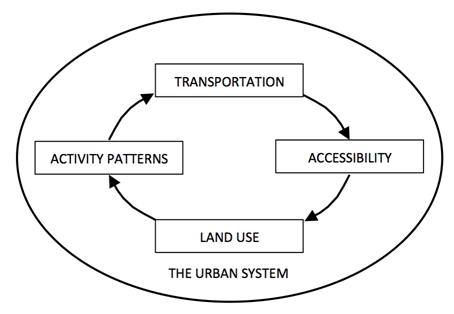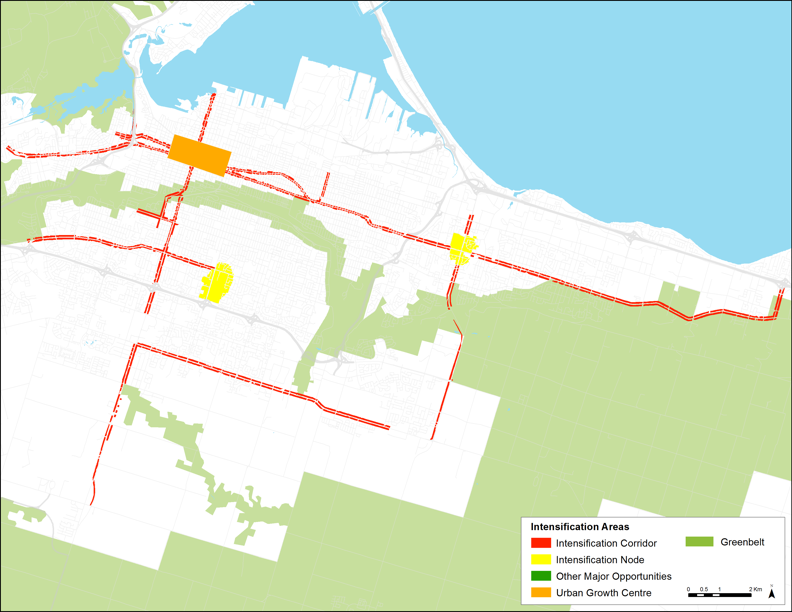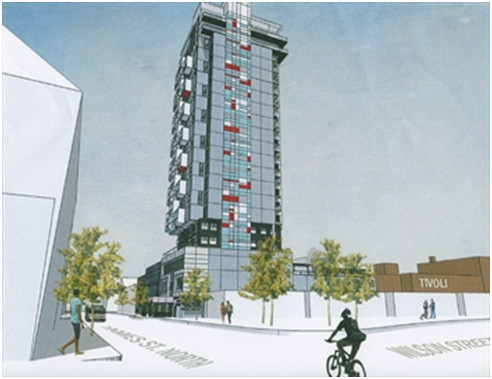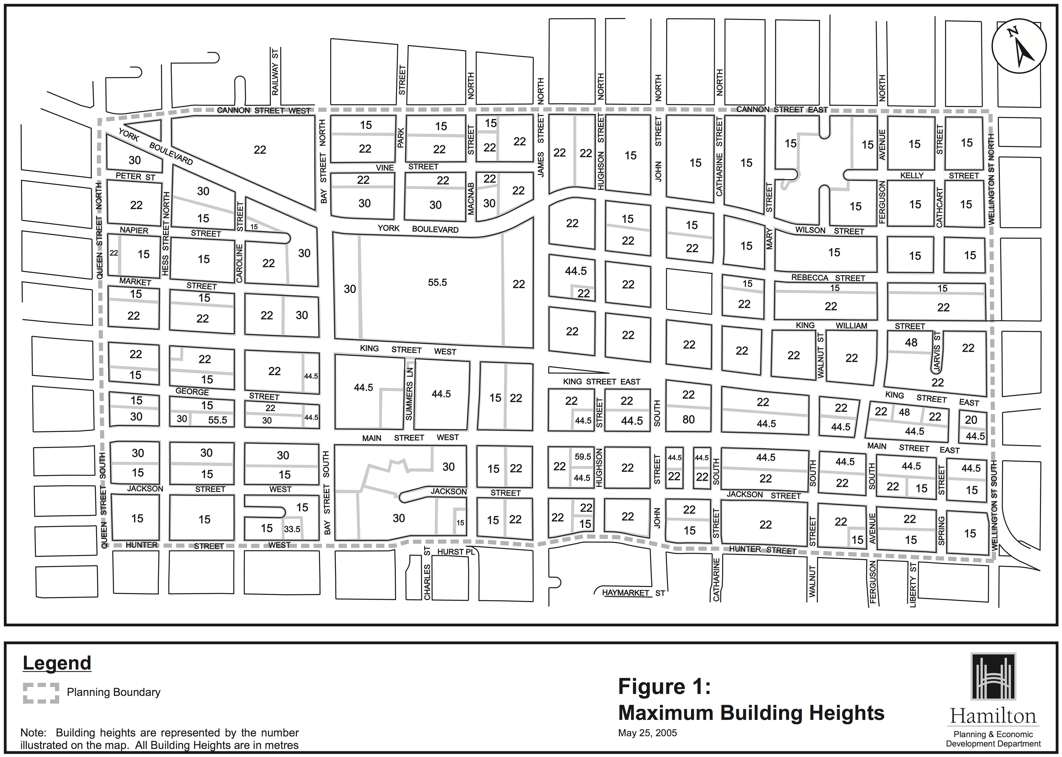Comprehensive zoning reform to implement transit-oriented development it is the single largest issue still to be overcome if transit ridership is to improve in this city over the long term.
By Chris Higgins
Published March 03, 2015
David Dixon's recent presentation to council on the Ten Year Transit Strategy notes the city is trending in the wrong direction.
In 2007 we set a long-term goal of reaching 80-100 transit rides per capita, and Dixon re-affirms this as a target to be achieved by 2025. However, this number has been declining for some time, from 51 in 1994 to 48 in 2005 and to 45 in 2013. Getting to 100 rides requires a near doubling of the per capita ridership from 20 years ago.
What's their solution? The presentation argues that the best way to achieve these goals is by improving service and adding capacity. This will only get us to 50 rides per capita, though. Going from 50 to 100 rides is something the plan admits won't be achievable without rapid transit.
As for things like dedicated transit lanes to help service in the near-term, the recent bus lane debate turfed all talk of such things to this year's Transportation Master Plan (TMP) Review Review.
So will this all come together to achieve 80-100 rides per capita? I am willing to bet that these initiatives will fail, at least in respect to producing meaningful changes in transit use.
While these initiatives are good on their own, we stubbornly refuse to acknowledge and deal with the other half of the problem to create a truly integrated strategy.

The Urban System
People don't travel for the sake of it. Land use shapes activity patterns. Transportation responds to activity patterns to affect levels of accessibility, which connects different types of land uses. Land use and transportation are a symbiotic system, and only looking at half of it and expecting full transformative change is madness.
To be fair, the previous TMP review produced a policy paper on Urban Structure and Land Use (and another on Urban Design) which I will get to in a second.
In fact, working backwards, Hamilton has, at least in written form, supported good urban growth and transportation policy. Hamilton's Vision 2020, first adopted in 1992 and re-affirmed by council in 2003, fed into the Growth Related Integrated Development Strategy (GRIDS) of 2006 that produced nine great directions to guide further planning documents.
Meanwhile at the provincial level, the McGuinty Liberal government was active in creating the regional growth planning trifecta:
From all this, the City's 2007 TMP argued on Page 31 that development should be focused into "targeted nodes and corridors served by transit to reduce the need for additional infrastructure development. Intensify uses and activities in these areas."
Two of several ways proposed by staff to do that were to:
The recommendations produced locally and the province's growth mandates fed into the Urban Official Plan in 2009, which delineated the Downtown Urban Growth Centre, the Eastgate Square and Limeridge Mall Intensification Nodes, and key Intensification Corridors throughout the city.
The downtown in particular is to achieve a minimum density target of 200 people and jobs per hectare by 2031 or earlier - my calculations using 2011 data indicate it is already at 811.

Map: Intensification Areas
Finally, the Nodes and Corridors study was designed to tie it all together to implement in support of rapid transit.
The project ran from 2010 to 2011 and was full of buzz-words: it would produce a high-level vision, set out principles to strategically guide growth along the B-Line corridor consistent with the idea of Transit-Oriented Development (TOD).
A good deal of public and developer engagement took place to solicit input, get feedback, and generate buy-in.
This is all great news. When done right, TOD, which is the promotion of higher-density, mixed-use, and pedestrian friendly complete-streets has been shown to offer a host of benefits (for our purposes here, the main one is increasing transit ridership).
However, the fundamental flaw is that after all the studies, all the visions, and all the principles, nothing really changed. Comprehensive zoning amendments to actually implement TOD never occurred, and transit continues to miss out on the Land Use half of the urban system.
While there are many elements to TOD-related zoning, I focus on two here. First, consider parking policies, which I touched on a few weeks ago.
City zoning requires minimum amounts of parking for all development downtown: 1 space for each new dwelling unit, 1 for every 3 persons in a retirement home, 1.25 for each classroom in an elementary school, 1 for every 50m2 of office or financial development (above 450m2) for example. To our credit, requirements are a bit lower in the downtown core than for the rest of the city.
But while parking is boring, it can have a profound effect on transportation choices. Dixon's presentation showed that transit ridership per capita in Hamilton is lower than our peers, and is declining. Is it any wonder? Look at the rules we set for land use, how they affect the city we've built, and how we travel in it:
People tend to make rational travel choices, going with the modes and routes that offer the least total cost. Parking in Toronto is scarce and expensive and congestion on the QEW can be horrendous. So you take the GO train to the core.
In Hamilton, swaths of cheap surface parking and one-way streets mean auto commuting is exceptionally easy, though such measures contribute to the loss of transit ridership and a vibrant downtown.
As an example, consider the Tivoli condos project. The Tivoli as proposed is 22 stories with 106 units and will have 69 parking spaces, 52 of which are to be in a three-storey podium.

Tivoli rendering
I don't know the breakdown of unit sizes (those less than about 540 ft2 don't require parking), but this project as planned likely isn't meeting zoning parking minimums and will seek an exemption. There is precedent for such a move: the 30-storey Connolly project on James South was approved with 259 units and only 122 spaces, 71 fewer than existing regulations would require.
Here, even accommodating that parking supply apparently requires the use of a car stacker. The solution here is easy, and I get into it below. But consider a second example of density and mid-rise development.
Beyond parking, the Tivoli project recently made news due to City planning staff calling for a rejection of the proposal.
While the lack of a business case to upgrade the theatre is a very reasonable part of it, staff also cited the project's density compared to the low- to medium-scale existing character of the area.
Weeding through the city's zoning maps, the Tivoli site at James North and Vine Street is in downtown zone D2 - Prime Retail Streets. According to the downtown zoning heights map, the maximum permitted use as-of-right is 22 metres, or a 6 to 7 storey building assuming 3.3 metres per storey.

Maximum building heights
I personally have no problem with such density. I think the project looks great and will add the extra vitality needed in the area.
But clearly the city is prioritizing mid-rise development on this site, and according to many of its planning documents, throughout the city's intensification nodes and corridors. However, existing zoning policies hurt what a Globe and Mail article refers to as the fragile economics of mid-rise development.
New buildings have generally fixed costs, such as the land and mechanical parts. With larger developments, these costs are spread over more units. Mid-rise means fewer units to share these costs and smaller margins for developers, which can already make many projects unviable.
But on top of the above, the addition of parking minimums, which on a small infill parcel likely means requiring underground or podium structured parking, greatly adds to the costs and complexity of a mid-rise project.
Furthermore, development uncertainty in terms of zoning changes or approvals to try and get around these issues or add height to spread costs and the potential for Ontario Municipal Board hearings also creates risk, adds cost, and eats into the economics of mid-rise.
Incredibly, beyond parking and zoning, there have even been reports of a recent downtown project that became unviable due to setback regulations required in case Main Street West ever needed to be widened even further.
Recent provincial changes allowing wood-framed structures up to 6 stories (instead of requiring concrete over 4 stories) helps tremendously to lower the costs of mid-rise construction, but there is clearly more we can do to facilitate such development if that is truly our priority.
Bringing this back to the discussion of transit trips, one of the most common ways to ensure TOD affects travel patterns is to reduce parking supply in new developments, typically through the imposition of parking maximums.
Overcoming the parking issue in Hamilton is simple: just change the word in the zoning by-law from minimum to maximum. Let the market decide how many spaces are warranted, up to a maximum. This gives the flexibility to promote TOD and transit ridership in advance of rapid transit and frees up a significant source of cost for mid-rise development. And if buyers and lenders demand maximum levels of parking in the near-term before rapid transit is here, so be it.
But to really get mid-rise to take off in support of TOD not only in the downtown core, but also the intensification nodes and intensification corridors as we have planned requires a streamlined planning process with clear and transit-oriented zoning. This supports as-of-right development that minimizes risk and red-tape and can make such development more viable.
These changes can be implemented as part of a set of Transit-Oriented Secondary Plans in the city's nodes and corridors, just like how we have a Downtown Secondary Plan already, and how TOD is implemented across North America.
Developers are already responding to the market: they're already building TOD - projects like the Tivoli and Connolly are high density, mixed-use developments in highly walkable neighbourhoods near transit, and with less parking.
Existing zoning ordinances run counter to this reality and require exemptions for these projects. While they seem to be getting approved anyhow, they nonetheless create delays and increase the risks and costs of development.
Despite what I have argued already, I recognize that this is a bit of a chicken-and-egg problem. For parking specifically, this would mean reducing parking supply to promote transit ridership, but in a city that is presently pretty car-dependent.
Of course, transit does exist and there are plans to increase service and capacity, but rapid transit would greatly increase service levels further. Still, some councillors believe we don't need rapid transit until we see ridership improve and congestion increase.
Then again, our existing urban form is, by design, extremely car friendly. Faced with enormous commuting flows to the industrial waterfront, we implemented congestion solutions based on the very best traffic engineering theories the 1950s had to offer and are now stuck with a legacy of extreme capacity.
This doesn't mean it all won't work, just that it won't be easy. It cannot be denied that land use and transportation are symbiotic. To achieve 80-100 transit trips per capita in 10 years is going to take change.
Transit is, of course, only a small part of the TMP, as many areas of the city have different needs, but we cannot go into the Ten Year Transit Strategoy or this year's TMP Review focusing only on only one half of the issue and expecting a full outcome.
Comprehensive zoning reform to implement TOD it is the single largest issue still to be overcome if transit ridership is to improve in this city over the long term, and will be instrumental in ensuring rapid transit is implemented in a way that maximizes ridership and fare revenue. Only in planning for transportation and land use simultaneously can we ever hope to achieve the transit goals we have set for ourselves.
I remain hopeful in the TMP and Transit Plan, but they're just not enough on their own. I'll be first to agree that zoning issues aren't as exciting as sketching out transit routes.
But permitting TOD as-of-right through transit-oriented Secondary Plans is something that needs to be done, and it looks like the appetite for such a discussion may be growing.
Still, given all of our visions and plans in the past and recent development momentum, this is something that should have been done yesterday.
By higgicd (registered) | Posted March 03, 2015 at 11:28:00
My article sum in one sentence: If we want to build a better city we need to change the rules of the game.
By KevinLove (registered) | Posted March 03, 2015 at 13:51:10
Most of the zoning rules that I have seen do not specify "parking" as being car parking. Fulfilling the parking requirements with bicycle parking would help to build a far better Hamilton.
Comment edited by KevinLove on 2015-03-03 13:51:44
By LOL_all_over_again (registered) | Posted March 04, 2015 at 21:47:32 in reply to Comment 109876
because there are thousands of bikes on the street in February
By Selway (registered) | Posted March 04, 2015 at 00:42:55
After reading the article (perhaps not with the attention it merits) and also Mr. Higgins' dissertation proposal, I can't help but wonder about the value downdraft of allowing as-of-right development to some unspecified in the article height/density/unit size in TOD zones while we're waiting for the train to actually arrive. Why invest in my property if someone will soon come along and buy my land for a great big something or other? As for the supposed market demand to which the Connaught, Connolly and Tivoli projects are responses...Where are these new tower dwellers going every morning? Somewhere way down the road to their job? If so, why are they downtown? GO? Maybe. Maybe somebody should ask the people who have ponied up for units at the Connaught where they are living and working now and why they are coming downtown, if they are? Almost all the actual building at present is occuring at the edges, particularly along the Rymal Road corridor. And it is almost all two story residential. TOD out there? Why? Who needs to travel from the power centre at Meadowlands to the identical item at Summit Park? In short, the main premise, that land use planning and transportation planning are necessarily complementary is of course unexceptionable; but the question is whether the City has just chosen to forget, or if it is tacit policy to separate them. I have no idea how one would be able to answer that at this point.
By LOL_all_over_again (registered) | Posted March 04, 2015 at 21:51:41
Cars are the predominant method of transportation of in this fair city. Doesn't it make sense then that such travel be as quick and easy as possible. As a society we believe in the greatest good for the greatest number. Most people drive therefore driving should be given priority over other methods of travel.
By lawjick (anonymous) | Posted March 04, 2015 at 23:12:35 in reply to Comment 109953
Everyone loves smoking. So doesn't it make sense that society should make smoking as cheap and easy as possible?
By higgicd (registered) | Posted March 04, 2015 at 22:51:01 in reply to Comment 109953
I don't imagine we will end up agreeing here, as I am coming to find this issue more a fundamental divide in preferences along generational and perspective lines. From my end I just don't see how your argument holds weight without ignoring all the serious damage auto-oriented policies have done to this city. My feelings on the issue are more or less summarized in a previous article http://raisethehammer.org/article/2451/d...
Suburban areas have their strengths, as do urban ones. Unfortunately trying to make an urban area more suburban and amenable to automobiles goes against the strengths of downtowns in density and economic agglomeration. Hamilton is not a unique snowflake in this regard - take Calgary, more than half of workers going downtown take the C-Train. To me mass transit epitomizes the greatest good for the greatest number in this case, and there's a clear rationale for transit getting priority over single-occupant vehicles. This so-called silent majority of car culture in Hamilton seems content to live the vision of the 1950s city but also to be so wilfully ignorant or dismissive of the damage it has caused.
By Selway (registered) | Posted March 05, 2015 at 00:01:04 in reply to Comment 109957
Isn't the problem that there are functionally two cities? The lower city runs east west between the mountain and the bay and is traversed by Main, Cannon, and the underused Burlington St/Industrial Drive. The upper city is traversed by Fennel, Mohawk, the Linc, and Rymal Road. The lower city has a centre and a number of distinct destinations: Mac, Bayfront plants, etc. The upper city has no centre and one edge, the escarpment. The southern edge is beyond Rymal and will eventually extend to Caledonia once the "airport employment growth district" pretense is dropped. I don't think it is helpful to dismiss the concerns of the upper city with moralizing remarks of this sort
"This so-called silent majority of car culture in Hamilton seems content to live the vision of the 1950s city but also to be so wilfully ignorant or dismissive of the damage it has caused."
People in the upper city are almost entirely dependent on their motor vehicles, but they did not build the world which, yes, they have chosen to inhabit. The conflict at the moment is between car-dependent people who wish to in effect "suburbanize" the lower city, and less car-dependent lower city people who would like to leverage density and destinations to become still less car-dependent. There is not much point trying to install rapid transit in the upper city, because the area is dispersed but homogenous: there are no destinations. At present, City Hall is building a second Mississauga on the mountain. Presumably at some point there will be a call to establish a "downtown", probably at the intersection of Rymal and Upper James, under the banner of "sprawl repair". ( There is a YMCA, a library and a police station near that junction already.)
I have been saying "upper Hamilton" but I'm not sure that is even meaningful. The people between say Concession and Mohawk may regard themselves as Hamiltonians, but by the time you get south of Rymal and east of Paramount, the gravity is quite attenuated. Waterdown? Those people in the outer subdivisions may as well be in the farther reaches of Gatineau, Denver or Louisville. It's a commonplace but it has serious political consequences. And the more City Hall builds out, the more votes there are out there, and the less relevant transit discussions are to them -- unless you can make a taxation argument. Or offer them something else, but what do you give people who think that they already have everything in the way of municipal goods that they need?
By notlloyd (registered) - website | Posted March 05, 2015 at 00:43:01 in reply to Comment 109960
Is the Answer to create separate cities? Or might the Answer be to stop the rape of the virgin land and with guts face the onslaught of the developers and force the re-development of the inner city?
I agree that demonizing innocent people is mistaken on this site. But Mr. Higgins' larger point is that allowing continued suburban expansion is ultimately a doomed proposition. A moratorium on residential development of farmland and some force to re-develop the lower city could be massively positive.
I do not believe the the LRT is the answer. It may be needed in time. But utilizing existing infrastructure to re-establish the lower city has ecological, financial and moral value. Or maybe they go hand in hand. But Mr. Higgins' bigger point is that there are huge planning issues at stake.
I certainly do not agree with all that he said, and you raise fabulous points, but one point cannot be ignored and that is that if developers cannot be refocused on the lower city, it will die and the Balkanization you speak of will become ensconced for generations.
Comment edited by notlloyd on 2015-03-05 00:44:41
You must be logged in to comment.
There are no upcoming events right now.
Why not post one?